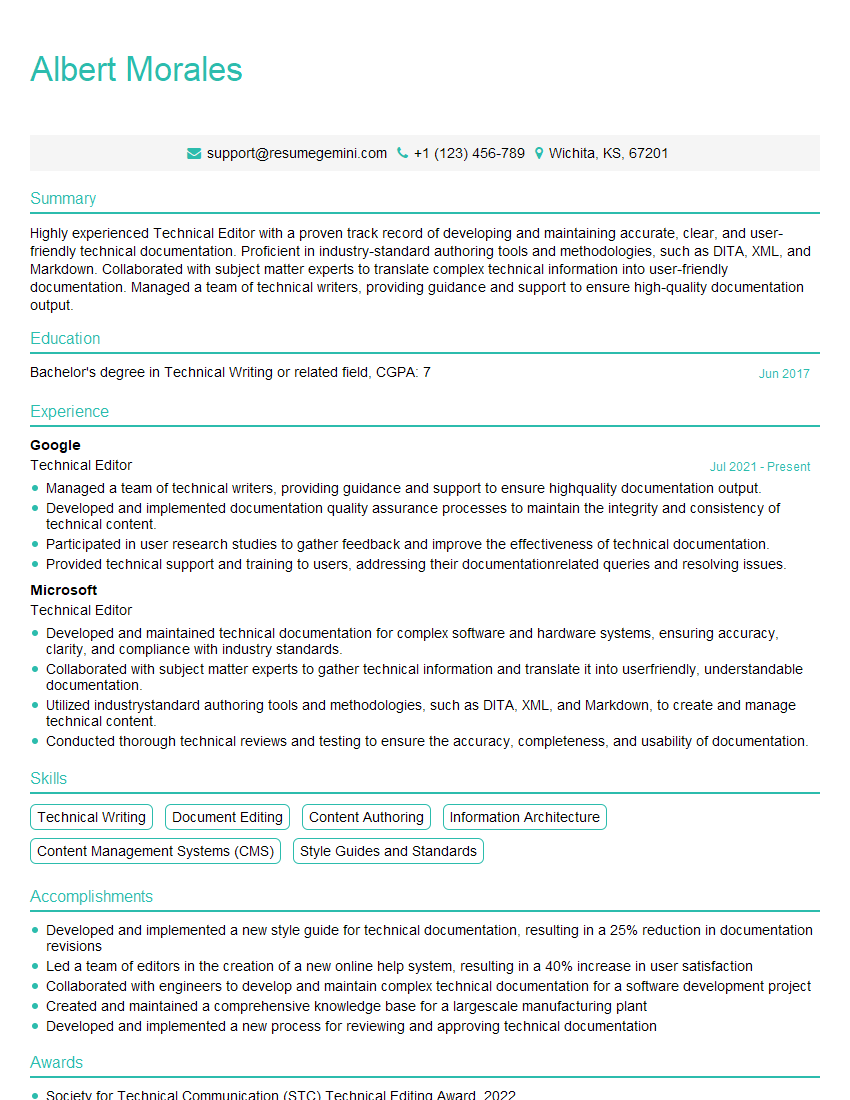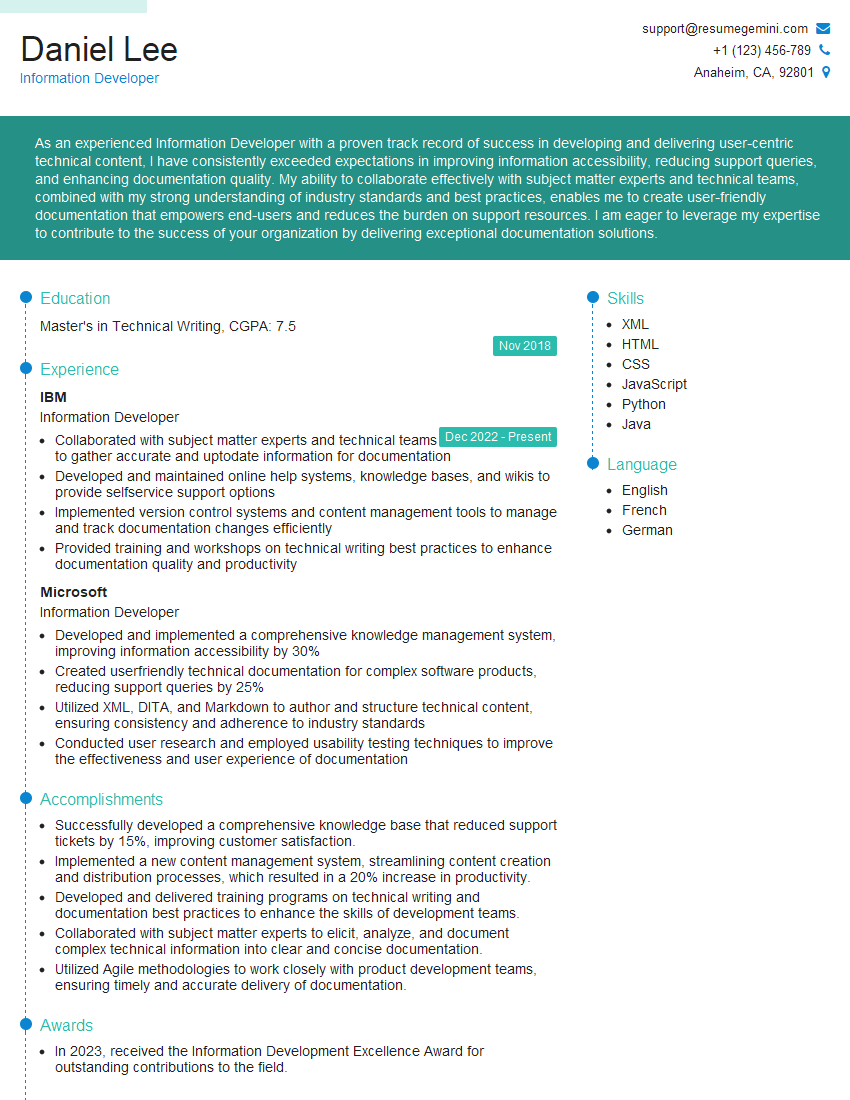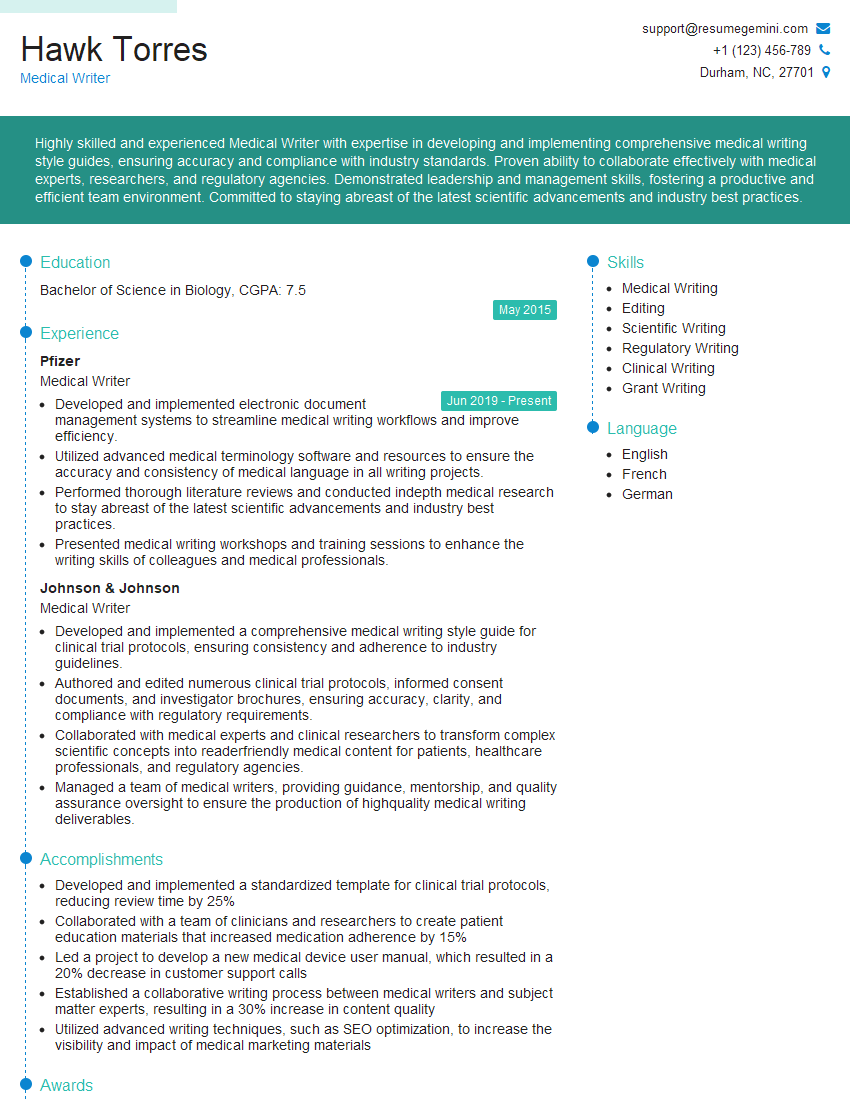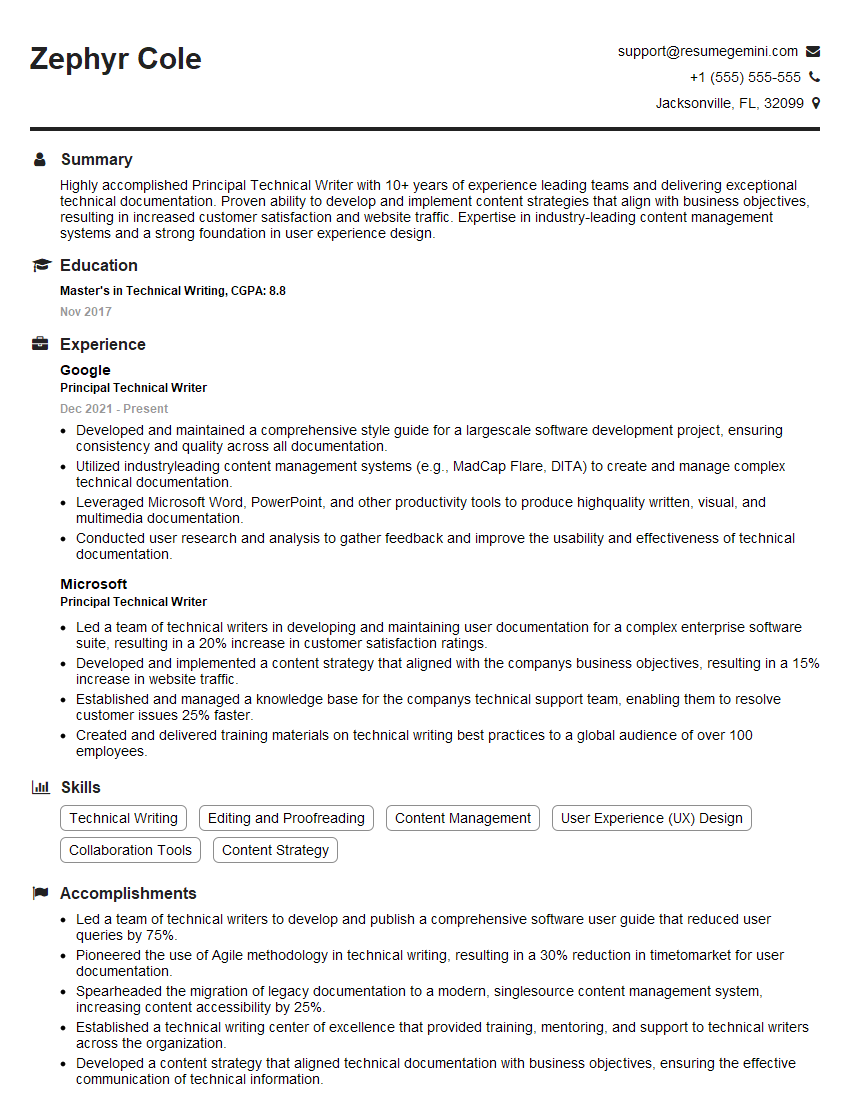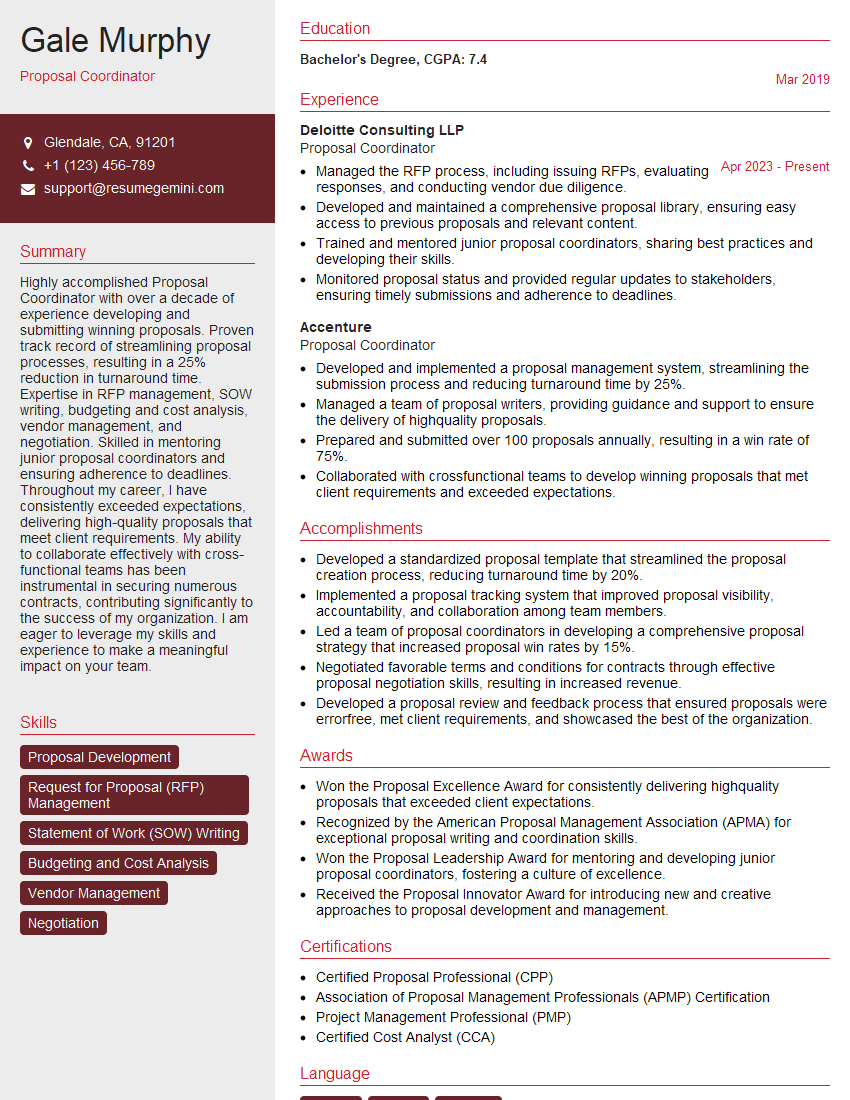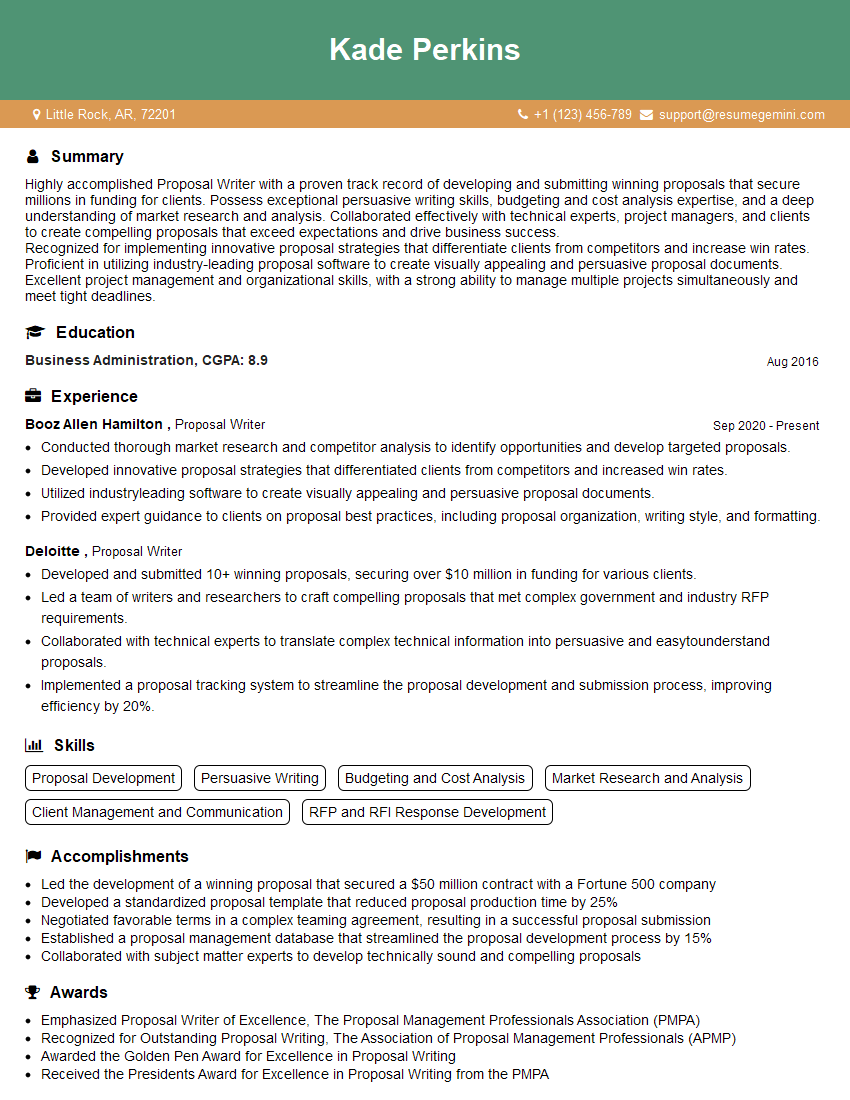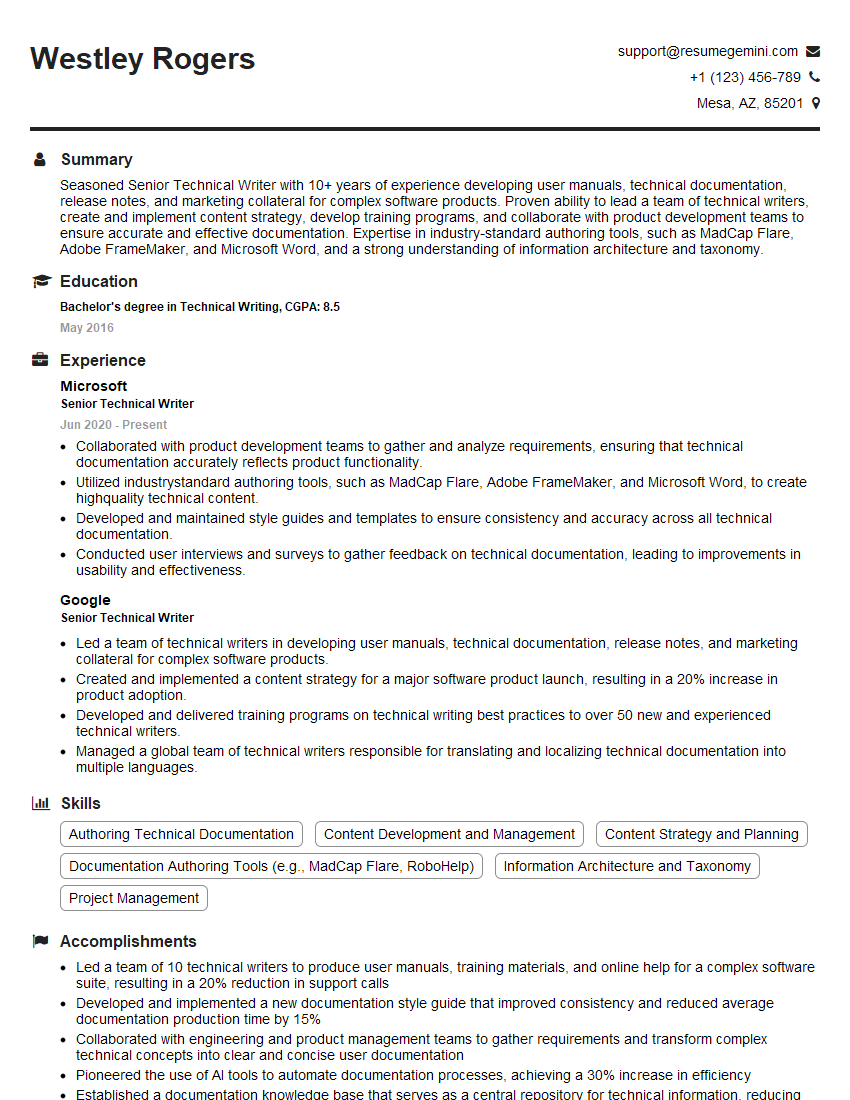Unlock your full potential by mastering the most common Technical Writing and Proposal Development interview questions. This blog offers a deep dive into the critical topics, ensuring you’re not only prepared to answer but to excel. With these insights, you’ll approach your interview with clarity and confidence.
Questions Asked in Technical Writing and Proposal Development Interview
Q 1. Explain your experience with various technical writing styles (e.g., user manuals, API documentation, white papers).
My experience spans a wide range of technical writing styles, each demanding a unique approach. User manuals, for example, prioritize clarity and ease of understanding for end-users, often employing a step-by-step, task-oriented approach. I’ve developed numerous user manuals, ranging from simple consumer electronics guides to complex software applications, always focusing on creating intuitive navigation and clear, concise language. API documentation, on the other hand, requires a more technical and precise style, focusing on functionality and code examples. I’ve extensively documented RESTful APIs and SDKs, using tools like Swagger to generate and maintain consistent documentation. Finally, white papers require a persuasive, authoritative tone, conveying technical information to a knowledgeable audience while advocating for a specific solution or technology. I’ve authored several white papers demonstrating the benefits of various software solutions and system architectures. Each style necessitates a careful consideration of the target audience and the information’s purpose.
Q 2. Describe your process for creating effective technical documentation.
My process for creating effective technical documentation is iterative and user-centric. It begins with a thorough understanding of the subject matter and the intended audience. I conduct user research, interviews, and analyze existing documentation to identify knowledge gaps and pain points. Next, I create a detailed outline, ensuring the information flows logically and comprehensively addresses the user’s needs. This involves careful task analysis to identify the specific steps users will need to follow. During the writing phase, I strive for clarity, precision, and consistency, using visuals like diagrams and screenshots where appropriate. A crucial part of my process is rigorous review and testing, both internally with colleagues and externally with representative users. Feedback is incorporated iteratively to refine the documentation and improve its usability. Finally, I use version control systems to manage revisions and collaborate effectively.
Q 3. How do you ensure accuracy and consistency in your technical writing?
Ensuring accuracy and consistency is paramount in technical writing. I achieve this through a multi-pronged approach. Firstly, I rely heavily on verifiable sources – technical specifications, code reviews, and subject matter experts (SMEs). Cross-referencing information from multiple sources is crucial to avoid discrepancies. Secondly, I employ style guides and templates to standardize terminology, formatting, and tone. This ensures consistency across all documents. Finally, I conduct rigorous reviews and quality assurance checks, involving both internal team members and external reviewers with relevant expertise. This includes thorough proofreading and fact-checking to catch any errors. Tools like style checkers and grammar software aid in this process, but human review remains essential for identifying nuanced inconsistencies.
Q 4. What tools and technologies are you proficient in for technical writing (e.g., MadCap Flare, DITA, XML)?
I’m proficient in several tools and technologies commonly used in technical writing. My experience includes using MadCap Flare for creating and managing complex, multi-channel documentation projects. I have also worked extensively with DITA (Darwin Information Typing Architecture) and XML for structured content creation, enabling single-sourcing and content reuse. I’m comfortable using version control systems like Git and SVN for collaborative document development and managing revisions. In addition to these specialized tools, I’m adept at using standard word processing and presentation software, such as Microsoft Word and PowerPoint.
Q 5. How do you handle conflicting information from different sources when writing technical documentation?
Handling conflicting information requires a systematic and meticulous approach. When faced with discrepancies between sources, I first attempt to resolve the conflict by carefully examining each source’s credibility and relevance. I might consult with SMEs to clarify the inconsistencies or review related documentation for further context. If the conflict remains unresolved, I document the discrepancy clearly in the documentation, explaining the different viewpoints and their potential implications. It’s vital to be transparent with the user about areas of uncertainty, rather than glossing over conflicting information, which could lead to user confusion or errors.
Q 6. Describe your experience with version control systems for technical documents.
I have extensive experience with version control systems, primarily Git, for managing technical documents. Using Git allows me to track changes, revert to previous versions, collaborate seamlessly with colleagues, and maintain a comprehensive history of revisions. This is particularly important for large, complex documentation projects, ensuring that the documentation is always up-to-date and consistent. I leverage branching and merging strategies to manage concurrent work and prevent conflicts. The ability to roll back to previous versions if necessary is invaluable in mitigating risks and ensuring the integrity of the documentation.
Q 7. Explain your understanding of single-sourcing and its benefits.
Single-sourcing is a crucial concept in technical writing, referring to the practice of creating and maintaining content in a single source, then repurposing that content across multiple outputs. This eliminates redundancy and ensures consistency. For example, a single paragraph describing a specific software function could be reused in a user manual, API documentation, and a knowledge base article, simply by adapting the surrounding content to suit the specific audience and context. The benefits of single-sourcing include improved consistency, reduced maintenance effort, easier updates, and lower overall costs. Using tools like DITA and XML facilitates single-sourcing by structuring content in a reusable format, enabling efficient content management and repurposing.
Q 8. How do you incorporate user feedback into your technical writing process?
User feedback is crucial for creating effective technical documentation. I integrate it throughout the writing process, not just at the end. My approach involves several key steps:
- Early Feedback: I solicit feedback early on, often during the planning stages, using surveys or informal interviews with target users to understand their needs and pain points. This helps shape the scope and content of the documentation.
- Usability Testing: I conduct usability testing with representative users to observe how they interact with the documentation. This reveals areas of confusion, missing information, or ineffective navigation.
- Iterative Revisions: Based on the feedback gathered, I revise the documents iteratively. This could involve clarifying confusing passages, adding illustrations or examples, or restructuring content for improved flow.
- Feedback Tracking: I maintain a record of all feedback received, including the source, date, and the actions taken in response. This ensures transparency and allows me to track the effectiveness of the revisions.
For example, in a recent project documenting a new software application, early user feedback revealed that the terminology used was too technical. By incorporating simpler language and adding more visual aids, I improved the document’s usability and comprehension significantly.
Q 9. How do you tailor your writing to different technical audiences?
Tailoring writing to different technical audiences is essential for effective communication. It’s like choosing the right tool for the job – you wouldn’t use a hammer to screw in a screw. I adapt my writing style, vocabulary, and level of detail based on the audience’s technical expertise and their needs.
- Identifying the Audience: First, I clearly define the audience. Is it a group of software developers, end-users, or system administrators? Their level of technical knowledge will dictate the complexity and technical depth of my writing.
- Adjusting Language: I adjust my language accordingly. For developers, I might use technical jargon and code examples. For end-users, I prefer plain language and avoid technical terms whenever possible. I might use analogies or metaphors to explain complex concepts.
- Structuring Content: I structure my content differently for different audiences. A detailed troubleshooting guide might be suitable for IT support staff, while a concise FAQ might be better for end-users.
- Using Visual Aids: Visual aids, such as diagrams, screenshots, and flowcharts, are invaluable for improving comprehension across all audiences. They complement the written text and can make even complex technical information easier to grasp.
For instance, when documenting a complex network configuration, I would use a detailed, technical approach for network engineers, including diagrams and configuration examples. However, for non-technical users, I would provide a simplified explanation focusing on the benefits and high-level functionality.
Q 10. Describe your experience with the proposal writing process.
My experience in proposal writing spans several years and diverse projects, encompassing everything from software development proposals to research grants. The process typically follows these stages:
- Understanding the RFP (Request for Proposal): Meticulously reviewing the RFP to understand the client’s needs, requirements, and evaluation criteria is paramount. This includes identifying key deliverables, timelines, and budget constraints.
- Developing a Winning Strategy: This stage involves brainstorming innovative solutions tailored to the client’s specific challenges. A clear understanding of the client’s goals and objectives forms the foundation of a compelling proposal.
- Content Creation: Crafting the proposal involves writing clear, concise, and persuasive content that showcases our expertise and proposed solutions. I carefully structure the proposal with a compelling narrative, incorporating visuals where appropriate.
- Collaboration and Review: I collaborate with subject matter experts and other team members to ensure the proposal’s technical accuracy and completeness. Multiple reviews and edits are crucial to identify and correct any shortcomings.
- Submission and Follow-up: After thorough review and final edits, the proposal is submitted according to the RFP’s specifications. Follow-up with the client to address any questions or concerns demonstrates professionalism and initiative.
For example, in a recent proposal for a large-scale software implementation, I tailored the approach to the client’s specific business needs, including cost-benefit analyses and a detailed implementation plan.
Q 11. What are the key elements of a successful proposal?
A successful proposal is more than just a document; it’s a persuasive argument that clearly articulates the problem, proposed solution, and value proposition. Key elements include:
- Clear Understanding of the Problem: Thoroughly understanding and clearly articulating the client’s problem is the cornerstone. The proposal should demonstrate a deep understanding of the client’s context and challenges.
- Compelling Solution: The proposed solution should be innovative, feasible, and clearly address the identified problem. It should be detailed and well-supported with evidence and examples.
- Strong Value Proposition: Highlighting the tangible benefits and return on investment (ROI) for the client is crucial. This demonstrates the value of the proposed solution and justifies the cost.
- Credibility and Expertise: Showcase your team’s experience, qualifications, and past successes. Client confidence is built through demonstrating competence and reliability.
- Professional Presentation: A well-structured, visually appealing, and error-free proposal demonstrates professionalism and attention to detail. Consistent formatting and clear language enhance readability.
A successful proposal often feels like a conversation with the client, not just a formal document.
Q 12. How do you research and gather information for a proposal?
Research and information gathering are vital for developing a comprehensive and persuasive proposal. My approach involves:
- Analyzing the RFP: The RFP itself is the primary source of information. It dictates the scope, deliverables, and client requirements.
- Client Communication: Direct communication with the client is essential to clarify ambiguities and gather additional insights. This might involve meetings, calls, or email exchanges.
- Secondary Research: Conducting secondary research, including online resources, industry reports, and relevant publications, helps to inform the proposal and strengthen its arguments.
- Internal Resources: Utilizing internal resources such as project proposals, case studies, and expertise from team members contributes to the accuracy and depth of the proposal.
- Data Collection: Collecting relevant data to support claims made in the proposal strengthens credibility and persuasiveness.
For example, when preparing a proposal for a website redesign, I would conduct user research to understand their needs and preferences, analyze existing website analytics, and research competitor websites to gather insights into best practices.
Q 13. How do you ensure compliance with RFP requirements?
Ensuring compliance with RFP requirements is crucial for proposal success. Non-compliance can lead to disqualification. My strategy includes:
- Meticulous Review: I thoroughly review the RFP multiple times, paying close attention to all instructions, deadlines, and submission guidelines.
- Developing a Checklist: Creating a checklist helps ensure that all requirements are addressed, and nothing is overlooked.
- Using Template Documents: Utilizing templates that are pre-formatted according to common RFP requirements speeds up the process and reduces the risk of errors.
- Team Collaboration: Involving other team members in the review process offers a fresh perspective and helps catch any omissions or inconsistencies.
- Proofreading and Editing: Thorough proofreading and editing are critical to ensure that the final document is free of grammatical errors and typographical mistakes.
For example, if the RFP specifies a particular page limit or formatting style, I ensure that the final submission adheres strictly to these guidelines.
Q 14. Describe your experience with proposal editing and review.
Proposal editing and review are iterative processes essential for producing a high-quality, persuasive document. My approach involves:
- Multiple Review Cycles: I typically conduct several review cycles, involving different team members with varied expertise. This allows for comprehensive feedback and identification of areas for improvement.
- Style and Tone Consistency: Maintaining consistent style and tone throughout the document enhances readability and professionalism. This includes checking for inconsistencies in grammar, punctuation, and terminology.
- Clarity and Conciseness: I strive for clarity and conciseness, ensuring that all information is presented in a logical and easily understandable manner. Eliminating jargon and ambiguity is critical.
- Accuracy and Completeness: I verify all facts, figures, and data presented in the proposal to ensure accuracy. I also check for completeness, making sure that all required sections are included.
- Visual Review: Reviewing the visual presentation, including formatting, layout, and graphics, is critical for maintaining a professional and visually appealing document.
A collaborative review process ensures the proposal is polished, accurate, and represents the best possible work of the team.
Q 15. How do you handle revisions and feedback on proposals?
Handling revisions and feedback on proposals is a crucial part of the process, demanding both diplomacy and a keen eye for detail. My approach involves a structured system ensuring all feedback is addressed thoroughly and efficiently. First, I meticulously review all comments, categorizing them by type (e.g., factual corrections, stylistic suggestions, strategic adjustments). This helps prioritize revisions based on impact. Then, I implement changes, making sure to maintain consistent formatting and style. For significant alterations, I always communicate the reasoning behind my decisions to the client or stakeholders. Finally, I provide a detailed change log, highlighting all modifications made. This transparency fosters trust and ensures everyone is on the same page. For instance, if a client requests a different emphasis on a certain project milestone, I’ll not only revise the text but also explain the updated strategic rationale in a separate communication.
Career Expert Tips:
- Ace those interviews! Prepare effectively by reviewing the Top 50 Most Common Interview Questions on ResumeGemini.
- Navigate your job search with confidence! Explore a wide range of Career Tips on ResumeGemini. Learn about common challenges and recommendations to overcome them.
- Craft the perfect resume! Master the Art of Resume Writing with ResumeGemini’s guide. Showcase your unique qualifications and achievements effectively.
- Don’t miss out on holiday savings! Build your dream resume with ResumeGemini’s ATS optimized templates.
Q 16. What strategies do you use to make proposals compelling and persuasive?
Creating compelling and persuasive proposals requires a blend of strong writing skills, strategic thinking, and a deep understanding of the client’s needs. I employ several strategies to achieve this. Firstly, I begin with a strong executive summary that concisely highlights the problem, solution, and value proposition. This is the proposal’s ‘hook,’ grabbing the reader’s attention immediately. Secondly, I focus on storytelling – presenting a narrative that showcases our expertise and how our solution directly addresses the client’s challenges. This approach makes the proposal more engaging and memorable than a simple list of features. Thirdly, I use strong visuals such as charts, graphs, and infographics to make complex data easier to understand. Finally, I ensure the proposal is tailored to the specific audience, using language and tone appropriate for their level of technical expertise. For example, a proposal for a government agency will differ significantly from one for a tech startup. Each requires a different level of formality and detail.
Q 17. How do you manage timelines and deadlines for proposal development?
Managing timelines and deadlines in proposal development demands meticulous planning and proactive communication. I start by creating a detailed project plan, breaking down the proposal into manageable tasks with assigned deadlines. This plan includes buffer time to account for unforeseen delays. I utilize project management tools like Gantt charts to visualize the workflow and track progress. Regular check-ins with the team keep everyone informed about progress and potential roadblocks. Open communication is key; any delays or challenges are addressed immediately. This proactive approach prevents minor issues from snowballing into significant problems. For instance, if a key team member is unavailable, we adjust the schedule accordingly, and I immediately notify the client about any potential impact on the delivery timeline.
Q 18. What is your experience with proposal response templates and style guides?
My experience with proposal response templates and style guides is extensive. I understand that consistency and adherence to guidelines are critical for professionalism and a strong brand image. I’m proficient in using various templates and style guides, adapting them to specific client requirements and proposal types. I understand the importance of following formatting rules, consistent use of terminology, and adherence to specific page limits or character counts. For example, I’ve worked with government RFPs (Requests for Proposals) requiring strict adherence to complex formatting and submission rules. I’ve also tailored templates for corporate proposals, focusing on a more concise and business-oriented style. Understanding these nuances helps ensure proposals are not only well-written but also compliant and easily understood by the recipient.
Q 19. How do you work collaboratively with other team members on proposal development?
Collaborative proposal development is essential. My approach is centered on open communication and clear roles. I believe in establishing a collaborative workspace where everyone feels comfortable contributing. We utilize project management software to track progress, share documents, and assign tasks. Regular team meetings ensure we stay aligned, address challenges, and brainstorm effectively. I actively solicit input from all team members, valuing diverse perspectives and leveraging individual expertise. This collaborative model prevents conflicts and ensures the proposal reflects the collective knowledge and creativity of the team. For example, if we have a graphic designer on the team, I actively involve them in deciding the visual elements of the proposal, ensuring the visuals reinforce the written content’s message.
Q 20. Explain your knowledge of different proposal types (e.g., government, corporate, grant).
I have experience with various proposal types, each requiring a nuanced approach. Government proposals often require strict adherence to regulations, detailed budgetary breakdowns, and clear articulation of how the proposal aligns with government objectives. Corporate proposals, on the other hand, usually focus on demonstrating return on investment (ROI) and aligning with the company’s strategic goals. Grant proposals emphasize the social impact and the organization’s capacity to deliver on the promised outcomes. Each requires a different style, tone, and level of detail. For instance, a government proposal might require extensive documentation of past performance, while a grant proposal might emphasize the innovative nature of the project and the anticipated societal benefits.
Q 21. How do you quantify the value proposition in a proposal?
Quantifying the value proposition is critical for persuasive proposals. I use various methods to achieve this, depending on the context. This may involve using financial metrics like ROI, cost savings, increased revenue, or efficiency gains. In cases where financial metrics are challenging to quantify directly, I use qualitative metrics, showcasing improved customer satisfaction, enhanced brand reputation, or reduced risk. It’s important to support these claims with data, case studies, or testimonials. For instance, instead of simply stating ‘improved customer satisfaction,’ I might cite specific data showing a quantifiable increase in customer satisfaction scores following a similar project. This provides concrete evidence to support the proposed value, making the proposal more convincing and credible.
Q 22. Describe your experience using proposal writing software (e.g., RFPIO, Loopio).
My experience with proposal writing software encompasses several platforms, most notably RFPIO and Loopio. I’ve leveraged these tools to streamline the proposal development process significantly, improving efficiency and consistency. RFPIO, for instance, excels at content management and automation, allowing for the rapid creation of tailored proposals by drawing from a library of pre-approved content blocks. This is particularly helpful when responding to multiple RFPs with similar requirements. With Loopio, I’ve found its collaborative features invaluable, facilitating seamless teamwork across different departments and stakeholders involved in the proposal process. The version control and approval workflows within these platforms have greatly reduced the risk of errors and ensured everyone is working with the most up-to-date information. I’m proficient in using their templating features to create consistent branding and messaging across all proposals, improving the overall professional image.
For example, in a recent project bidding for a large-scale software implementation, I utilized RFPIO’s content library to quickly assemble responses to common questions about our methodology and experience. Loopio’s collaborative features were critical in managing feedback from subject matter experts and ensuring all technical details were accurately reflected. This resulted in a high-quality proposal submitted on time and under budget.
Q 23. How do you measure the success of a proposal?
Measuring the success of a proposal goes beyond simply winning the bid. While a successful win is certainly a key indicator, a holistic assessment involves evaluating multiple factors throughout the proposal lifecycle. This includes tracking metrics like proposal response time, the number of revisions required, and stakeholder satisfaction. But the ultimate measure is tied to the project’s overall impact.
- Win Rate: The percentage of proposals submitted that resulted in a successful contract. This helps assess the overall effectiveness of our proposal strategy.
- Client Feedback: Gathering feedback from clients, both successful and unsuccessful bids, provides valuable insights into areas for improvement. This may uncover issues in clarity, persuasiveness, or alignment with client needs.
- Project Outcomes: After the project is completed, we evaluate how well the proposal’s promises translated into reality. Did we meet or exceed expectations? Did the deliverables match the scope outlined?
- Cost-Benefit Analysis: We analyze the cost of developing each proposal against the potential revenue generated from successful bids. This ensures our resources are efficiently allocated.
For example, even if we lost a bid, positive client feedback might highlight the strengths of our proposal’s technical section, guiding us to refine other aspects.
Q 24. Describe a time you had to adapt your writing style to suit a specific audience or project.
Adapting writing style is crucial for effective communication. A recent project involved creating documentation for a complex software application – one set for a technical audience (software engineers) and another for a non-technical audience (marketing and sales teams). For the engineers, I adopted a concise, precise style with technical jargon and detailed explanations of the software’s architecture and functionalities. I used diagrams and flowcharts to illustrate complex processes.
In contrast, the documentation for the marketing and sales teams focused on the software’s benefits and value proposition. I avoided technical terms and opted for a more narrative approach, using clear and concise language to explain how the software could help them achieve their business objectives. This required a complete shift in vocabulary and tone – moving from a highly specific style to a more general, benefit-driven one. The success of this project demonstrated the importance of tailoring your writing style to the specific knowledge and needs of the audience to ensure optimal understanding and engagement.
Q 25. How do you stay current with best practices in technical writing and proposal development?
Staying current in technical writing and proposal development requires a multifaceted approach. I actively engage in several key strategies:
- Professional Development: I regularly attend webinars, workshops, and conferences focused on technical communication and proposal writing best practices. This ensures I’m up-to-date on the latest trends and technologies.
- Industry Publications and Journals: I subscribe to and follow leading journals and publications in the field, staying abreast of new research and methodologies.
- Online Courses and Certifications: I regularly explore online courses and certification programs that offer deeper dives into specific areas of expertise, such as content strategy or accessibility standards.
- Networking: I actively participate in professional organizations and online communities to exchange knowledge and learn from peers.
- Mentorship: I actively seek mentorship from experienced technical writers and proposal developers to learn from their experiences and best practices.
This ongoing learning ensures my skills and knowledge remain sharp and relevant to the ever-evolving landscape of technical communication.
Q 26. Describe your experience with creating graphics and visuals for documentation.
Creating effective graphics and visuals is a critical skill in technical writing and proposal development. I have extensive experience crafting visuals using tools like Adobe Creative Suite (Photoshop, Illustrator, InDesign) and also simpler tools such as PowerPoint and Google Slides, depending on the complexity required. I believe that well-designed visuals significantly enhance comprehension and engagement. My approach is to prioritize clarity and accuracy above all else. For example, when creating diagrams to explain a software architecture, I ensure the components are clearly labeled, connections are unambiguous, and the overall visual design is clean and uncluttered.
In proposals, I might use charts and graphs to visually present data, infographics to convey key messages, and mockups to illustrate the features of a product or service. In technical documents, I employ diagrams to illustrate processes and system architectures, and screenshots to demonstrate software interfaces. The key is to select the most appropriate visual to suit the information being presented and the target audience.
Q 27. How do you handle difficult stakeholders during the proposal development process?
Handling difficult stakeholders requires a combination of proactive communication, empathy, and strong negotiation skills. The key is to establish clear expectations and communication channels early in the process.
- Active Listening: I always start by actively listening to understand their concerns and perspectives. This helps identify the root cause of the conflict.
- Clear Communication: I ensure all communication is clear, concise, and well-documented. This minimizes misunderstandings and keeps everyone informed.
- Collaborative Problem-Solving: I encourage a collaborative approach to problem-solving, working with stakeholders to find mutually agreeable solutions. This demonstrates respect for their input and helps to build consensus.
- Compromise and Negotiation: I’m always willing to compromise and negotiate to find solutions that satisfy everyone’s needs as much as possible.
- Escalation Protocol: In cases where conflict cannot be resolved, I have a clear escalation protocol in place, ensuring issues are addressed by the appropriate decision-makers.
For example, I once encountered a stakeholder who insisted on including irrelevant information in the proposal. By actively listening to their rationale and explaining the potential negative impact on the proposal’s overall effectiveness, we reached a compromise where we included a concise summary of their concerns in an appendix.
Q 28. Explain your experience with accessibility standards in technical documentation.
Accessibility is paramount in technical documentation. I’m deeply familiar with WCAG (Web Content Accessibility Guidelines) and strive to create documentation that is usable by individuals with a wide range of disabilities, including visual, auditory, motor, and cognitive impairments. My approach involves several key strategies:
- Alternative Text for Images: I provide descriptive alt text for all images to ensure screen reader users can understand the visual content.
- Proper Heading Structure: I use heading levels (H1, H2, H3, etc.) to create a logical structure for the document, making it easier for screen readers to navigate.
- Color Contrast: I ensure sufficient color contrast between text and background colors to enhance readability for users with low vision.
- Keyboard Navigation: I make sure all interactive elements can be accessed and operated using only a keyboard.
- Structured Content: I use structured authoring tools and formats (like XML) to ensure the content is semantically rich and easily adaptable for various assistive technologies.
For instance, I recently worked on a technical manual where I ensured that all images had accurate alt text, the document followed a clear heading structure, and color contrast met WCAG guidelines. This made the manual accessible to users with visual impairments, improving its overall usability.
Key Topics to Learn for Technical Writing and Proposal Development Interview
- Understanding Your Audience: Learn to tailor your writing style and technical depth to different audiences, from engineers to executives.
- Information Architecture & Structure: Master techniques for organizing complex information logically and effectively, creating clear and concise documents.
- Style Guides & Documentation Standards: Familiarize yourself with common style guides (e.g., Chicago Manual of Style) and industry-specific documentation standards.
- Technical Writing Principles: Grasp core principles like clarity, accuracy, conciseness, and accessibility in technical communication.
- Proposal Development Process: Understand the stages of proposal writing, from needs analysis and research to writing compelling narratives and persuasive arguments.
- Visual Communication: Learn to effectively use visuals (charts, diagrams, tables) to enhance understanding and engagement.
- Collaboration & Feedback: Practice collaborating with subject matter experts and incorporating feedback to improve documents.
- Content Management Systems (CMS): Gain familiarity with common CMS platforms used in technical writing and proposal development.
- Problem-Solving in Technical Communication: Develop strategies to address challenges like complex technical concepts, conflicting information, and tight deadlines.
- Software & Tools: Familiarize yourself with common technical writing tools (e.g., MadCap Flare, Microsoft Word, Adobe Acrobat).
Next Steps
Mastering technical writing and proposal development opens doors to exciting career opportunities and significantly boosts your earning potential. These skills are highly sought after across various industries, offering excellent job security and growth prospects. To maximize your chances of landing your dream role, creating a strong, ATS-friendly resume is crucial. ResumeGemini is a trusted resource that can help you build a professional resume that truly showcases your skills and experience. ResumeGemini provides examples of resumes tailored specifically to Technical Writing and Proposal Development, giving you a head start in crafting a compelling application.
Explore more articles
Users Rating of Our Blogs
Share Your Experience
We value your feedback! Please rate our content and share your thoughts (optional).
What Readers Say About Our Blog
Dear Sir/Madam,
Do you want to become a vendor/supplier/service provider of Delta Air Lines, Inc.? We are looking for a reliable, innovative and fair partner for 2025/2026 series tender projects, tasks and contracts. Kindly indicate your interest by requesting a pre-qualification questionnaire. With this information, we will analyze whether you meet the minimum requirements to collaborate with us.
Best regards,
Carey Richardson
V.P. – Corporate Audit and Enterprise Risk Management
Delta Air Lines Inc
Group Procurement & Contracts Center
1030 Delta Boulevard,
Atlanta, GA 30354-1989
United States
+1(470) 982-2456


